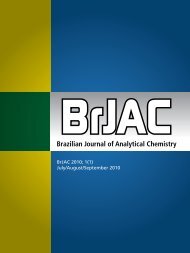Brazilian Journal of Analytical Chemistry - BRJAC - Brazilian Journal ...
Brazilian Journal of Analytical Chemistry - BRJAC - Brazilian Journal ...
Brazilian Journal of Analytical Chemistry - BRJAC - Brazilian Journal ...
You also want an ePaper? Increase the reach of your titles
YUMPU automatically turns print PDFs into web optimized ePapers that Google loves.
Pereira et al.<br />
oil, as S, Ni and V [8-10] and crude oil fractions [11-13].<br />
However, chlorine determination in this kind <strong>of</strong> samples<br />
was not currently described in literature.<br />
Significant improvement has been achieved in sample<br />
digestion techniques over the last years mainly due to the<br />
development <strong>of</strong> microwave-assisted digestion in pressurized<br />
vessels.[14,15] The use <strong>of</strong> conventional techniques<br />
based on microwave-assisted acid digestion presents<br />
some drawbacks for some matrices despite the spread<br />
and successful application to many other samples. In general,<br />
the relatively high stability <strong>of</strong> some organic materials<br />
(as, e.g., crude oil fractions) impairs an efficient and complete<br />
digestion.[16] In addition, the use <strong>of</strong> concentrated<br />
acids presents some problems for further chlorine determination,<br />
as possible analyte losses even using closed vessels<br />
for sample digestion [17,18] and interferences in the<br />
determination step by ion chromatography (IC).[19-21]<br />
In this sense, microwave-induced combustion (MIC)<br />
was proposed in the last years for organic samples digestion<br />
based on the sample combustion in closed vessels<br />
pressurized with oxygen after ignition by microwave<br />
radiation. After combustion, analytes can be absorbed<br />
in a suitable solution.[16] This method was successfully<br />
applied for decomposition <strong>of</strong> biological samples [22],<br />
elastomers [23,24], carbon nanotubes [25] and fossil<br />
fuel samples, as coal [26], petroleum coke [27,28], heavy<br />
crude oil [17,29] and its derivates [10,30] using diluted<br />
solutions for most <strong>of</strong> applications. Concerning halogens<br />
determination, alkaline media or even water could be<br />
used as absorbing solution with good recoveries.[27,29]<br />
In this work, microwave-induced combustion is proposed<br />
for the first time for atmospheric residue and gas<br />
oil digestion for further chlorine determination by IC.<br />
For results comparison, Cl determination was also performed<br />
by inductively coupled plasma mass spectrometry<br />
(ICP-MS). Parameters related to the influence <strong>of</strong><br />
sample mass, maximum pressure achieved during the<br />
combustion process and oxygen pressure were investigated.<br />
The type (H 2 O, (NH 4 ) 2 CO 3 and NH 4 OH) and the<br />
concentration <strong>of</strong> absorbing solutions were also investigated.<br />
As no certified reference materials (CRM) are<br />
available for chlorine in a similar matrix, a CRM <strong>of</strong> coking<br />
coal and fuel oil were used to evaluate the accuracy<br />
and spiked samples were also performed.<br />
2. ExPErimEntal<br />
2.1. InstrumentatIon<br />
A multiwave 3000 microwave sample preparation<br />
system [31] equipped with high pressure quartz vessels<br />
was used for MIC procedure. The vessels have internal<br />
volume <strong>of</strong> 80 ml and they support maximum pressure<br />
and temperature <strong>of</strong> 80 bar and 280 ºC, respectively.<br />
The s<strong>of</strong>tware version was changed to v1.27-Synt to run<br />
with a maximum pressure rate <strong>of</strong> 3 bar s -1 during the<br />
digestion.<br />
An ion chromatographic system (Metrohm, Herisau,<br />
Switzerland) equipped with a pump (IC liquid handling<br />
unit), compact autosampler (model 813) and conductivity<br />
detector (model 819) was used for chlorine determination<br />
using a Metrosep A Supp 5 column (150 x 4<br />
mm i. d.) composed by polyvinyl alcohol with quaternary<br />
ammonium groups and with particle size <strong>of</strong> 5 µm<br />
and a guard column (Metrosep A Supp 4/5 Guard) with<br />
the same packing material and particle size <strong>of</strong> analytical<br />
column. The operational conditions were set according<br />
to previous work [27] and are shown in Table I.<br />
For results comparison, an inductively coupled plasma<br />
mass spectrometer (PerkinElmer-SCIEX, Model Elan<br />
DRC II, Thornhill, Canada) equipped with a concentric<br />
nebulizer (Meinhard Associates, Golden, USA), a baffled<br />
cyclonic spray chamber (Glass Expansion, Inc., West<br />
Merbourne, Australia) and a quartz torch with a quartz<br />
injector tube (2 mm i.d.) was used for the determination<br />
<strong>of</strong> Cl. Argon 99.996% (White Martins - Praxair, São<br />
Paulo, Brazil) was used for plasma generation, nebulization<br />
and auxiliary gas. Instrumental performance optimization,<br />
including nebulizer gas flow rate, RF power<br />
and ion lens voltage, was performed and operational<br />
conditions were set according previous work.[26] The<br />
operational conditions for Cl determination by ICP-MS<br />
are also shown in Table I.<br />
taBlE i. oP E ra t i o n a l C o n d i t i o n s o f<br />
Ci d E t E r m i n a t i o n By iC a n d iCP-ms<br />
Residual carbon content determination in digests obtained<br />
by MIC was carried out in a model Spectro Ciros<br />
CCD simultaneous spectrometer with axial view configuration.[32]<br />
Plasma operating conditions and selected<br />
wavelength are described in reference [26].<br />
2.2. re a g e n t s a n d sample preparatIon<br />
All reagents used were <strong>of</strong> analytical grade. Purified<br />
water with a Milli-Q system (18.2 MΩ cm, Millipore,<br />
Billerica, USA) was used to prepare the mobile phase,<br />
120 Br J Anal Chem



